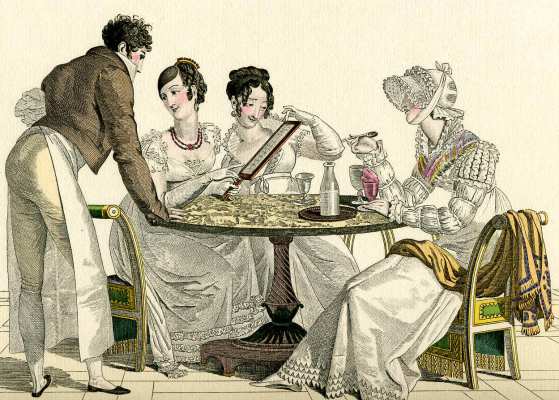
My dear Cassandra,—I take the first sheet of fine striped paper to thank you for your letter from Weymouth, & express my hopes of your being at Ibthorp before this time. I expect to hear that you reached it yesterday Evening, being able to get as far as Blandford on wednesday.—Your account of Weymouth contains nothing which strikes me so forcibly as there being no Ice in the Town; for every other vexation I was in some measure prepared; & particularly for your disappointment in not seeing the Royal Family go on board on tuesday, having already heard from Mr Crawford that he had seen you in the very act of being too late. But for there being no Ice, what could prepare me?
(from Jane Austen’s letters, 14 September 1804)
As it’s so hot here that my brain is slowly melting (the majority of houses in this part of the world don’t have AC), I thought we could talk about desserts. Ice creams in particular. (And I certainly feel for poor Cassandra—no ice cream! Gah!) (Why is there no ice cream in my freezer?!!?!?)
Last November Myretta wrote a post about ice houses and how ice cream was made in the Regency period, while in a post in April Rose showed us an ice-pail, in which ice cream was brought to the table. (Wait, you don’t eat it straight out of the bowl? Because homemade ice cream is, like, the best thing in the world!)
When I looked up various ice cream recipes from the Regency period, I was quite surprised to see that a lot of recipes call for putting the cream with the sugar and/or jam/fruit puree directly into the freezing pot. In my experience, it’s easier to use a thick custard as the base for ice cream: it’s creamier from the get-go & thus freezes more easily (though admittedly, there’s always the danger that you end up eating the custard before you get around to making the ice cream…).
In The Complete Confectioner, Frederick Nutt describes the historical method of making ice cream: the freezing pot with the ice cream base is put into a pail packed with ice and salt and rotated until the base has frozen. Nutt also elaborates on the difficulties and pitfalls of making ice cream: “[D]o not be sparing of salt, for if you do not use enough it will not freeze” (from the 1807 edition, which you can find on Google Books). And there’s nothing more frustrating than when your ice cream won’t freeze!
I’ve long loved Nutt’s book, and the section on ice creams is particularly awesome. For not only does he suggest adding a little cochineal to give your ice cream a pretty color, but he also lists 32 (THIRTY-TWO!!!!) different recipes, with flavours ranging from raspberry ice cream to biscuit ice cream to Parmasan ice cream. That’s a man after my own heart!
In contrast to poor Cassandra in Weymouth in 1804, many of Jane Austen’s characters get to enjoy ice cream. In Northanger Abbey Maria Thorpe tells Catherine, the heroine, about an outing the day before:
“—that they had driven directly to the York Hotel, ate some soup, and bespoke an early dinner, walked down to the pump–room, tasted the water, and laid out some shillings in purses and spars; thence adjoined to eat ice at a pastry–cook’s, and hurrying back to the hotel, swallowed their dinner in haste, to prevent being in the dark; and then had a delightful drive back, only the moon was not up, and it rained a little, and Mr. Morland’s horse was so tired he could hardly get it along.”
A rather more exciting visit to a pastry cook’s can be found in The Beautiful Cassandra, one of Austen’s very early works:
“She then proceeded to a Pastry-cooks where she devoured six ices, refused to pay for them, knocked down the Pastry Cook and walked away.”
Tee-hee!
And now please excuse me while I go & rummage in the freezer in the hope of finding some hidden carton of ice cream.

Fun post, Sandra! Ice cream is a popular item in my household, and we still make jokes about my late dad’s addiction to it. But I seldom think about it as a Regency food item, which it obviously was, given the fame of Gunther’s, and all those published recipes you discovered! I must try to give my characters more opportunity to enjoy Ices!! I don;t want them feeling deprived. 🙂